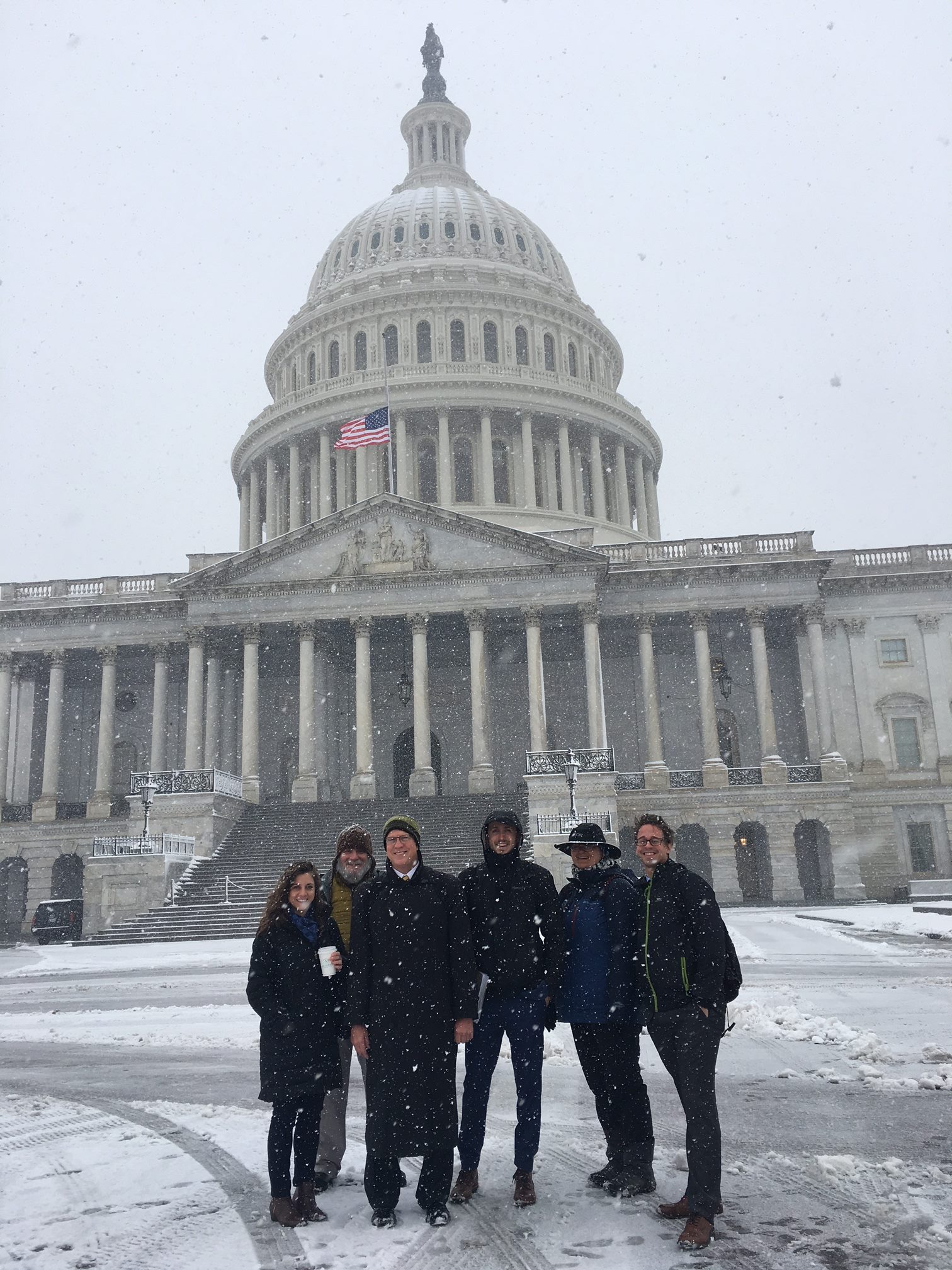Making It To 2025
In early 2018, our Pollution Limits workgroup developed a joint advocacy plan to ensure strong and coordinated outreach among Coalition members ahead of the midpoint assessment, which indicated how close we are to reaching our bay restoration goals. This included strategies on how to communicate with the public about the successes of the cleanup and ways to engage and educate local officials about the importance of clean water projects. Many of the Coalition’s members participated in the development of the plan and have already started taking action.
As we enter the last phase of the cleanup, we have an opportunity to advocate for strong Phase III Watershed Implementation Plans (WIPs), which outline how Bay jurisdictions, including local governments, will achieve pollution reductions from now through 2025. As a part of the advocacy plan, the Coalition developed Engagement Guides for each state that provide our members with information and resources they need to advocate for strong WIPs. This advocacy plan builds the capacity of our members to engage in the restoration effort and helps to further our goal of returning clean water to the region.
Supporting Virginia Farmers
The Virginia Agricultural Cost-Share (VACS) program has distributed more than $200 million dollars to help thousands of farmers and landowners implement practices like stream exclusion fencing and forest buffers, which help prevent pollution from reaching local waterways and the Chesapeake Bay. In 2018, the Coalition’s Communications Workgroup partnered with our Virginia members to demonstrate the need for increased and sustained funding for the VACS program to the Virginia General Assembly.
The workgroup identified and created materials that would be helpful in conducting educational outreach to newly elected officials, including one-pagers, before and after photos of projects, testimonials, and talking points. The workgroup also determined that a series of videos highlighting Virginia farmers utilizing the state cost-share program would help to elevate this issue.
The Coalition interviewed three different farmers from strategic areas of Virginia about their experience with the VACS program and why the funding is so important. What the videos show is that farmers not only benefit economically from installing these projects, but they also understand the importance of conservation and want to protect their local waterways.
Stormwater Success Stories
A key component of ensuring that we are consistently moving the needle forward when it comes to reducing pollution is telling the story of the importance of on the ground restoration projects. This can be difficult since the projects and practices the Chesapeake community are advocating for are often confusing and jargon-filled concepts. A goal of the Coalition is to work with our members to overcome these barriers and identify ways that our community can better communicate and promote clean water projects around the watershed.
To support this effort, the Coalition partnered with Maryland LCV and the MOST Center on a Stormwater Success Stories outreach campaign. Maryland LCV and MOST Center worked together to produce the “POLLUTION SOLUTIONS: Case Stories from the Chesapeake” website. This interactive site is a tool that allows users to search through more than 50 different real-life pollution reducing projects in Maryland based on location or project type. The purpose is to provide a one stop shop for visitors to access and even download information on projects that can then be used for their promotional or educational purposes. Many Coalition members have downloaded project descriptions for use in meetings with their local governments to encourage support for stormwater projects in their own communities.
September 2018 Stormwater Success Stories Training with Water Words that Work
Knowing that members were using these one-pagers in meetings with elected officials, we wanted to ensure that we were setting our members up for success. The Coalition partnered with Maryland LCV to apply for funding from the National Fish and Wildlife Foundation to train our members on best practices when it comes to communicating about stormwater projects using these one-pagers. In September 2018, the Coalition hosted its first training with Water Words That Work and more than 20 members of the Coalition. The day-long event focused on training our members through interactive role playing exercises and provided our members with takeaways that they could use in future meetings. Many of the attendees were from Montgomery County, Maryland, where almost all of their County Council members are term limited, meaning a whole new group of council members will need to be educated on the importance of funding stormwater projects. This will be the perfect opportunity for Coalition members to execute what they have learned.
In addition, the Coalition is working with members who attended the first training in September and utilizing existing meetings and forums to continue to train more Coalition members. In partnership with EarthForum of Howard County, who attended the training, the Coalition is presenting at a half-day event on communicating about stormwater success stories and Maryland LCV and Rock Creek Conservancy, who also attended the first training, will also be conducting a training at the Chesapeake Watershed Forum in November 2018. The Coalition is looking forward to seeing these new tools and skills executed in real-time in the coming months and years as we push for stronger support for these on the ground restoration projects.
Maryland's Fight for Forest Conservation
During this year's legislative session, the Coalition and its members in Maryland had a number of priorities, including improving the Forest Conservation Act (FCA). Between 1982 and 1997, the Chesapeake Bay watershed lost more than 750,000 acres of forestland. Today, there are about 24 million acres of forest and the watershed is losing about 70 acres each day. Maryland has not altered its FCA since 2013, which made this a priority for our members.
Our state lead, Maryland League of Conservation Voters, brought together more than 15 members of the Coalition around this issue to help coordinate and strategize around how to increase pressure to pass a new version of the bill. MDLCV held weekly calls where Coalition members would volunteer their time and support for writing op-eds, sending emails to state legislators, and even organized a lobby day.
In addition, the Coalition used this as an opportunity to pilot the first joint petition among Coalition members. A joint petition is when a number of groups sign their organization on to the same petition and send it out to their supporters for signing. When people see that a number of organizations are supporting a common goal, it can be much more powerful and increase signatures. This also acts as a list building campaign, where the participating organizations receive a new list of names of supporters from their fellow participants. This is something that has been done in other neighboring watershed, and the Coalition has wanted to try it in the Chesapeake.
The FCA joint petition included 10 Coalition members: National Wildlife Federation, Chesapeake Bay Foundation, League of Conservation Voters, Alliance for the Chesapeake Bay, Potomac Conservancy, Blue Water Baltimore, Clean Water Action, Maryland League of Conservation Voters, South River Federation, and Severn River Association. These organizations were selected due to their varying sizes, location, capacity, and member lists. After running the joint petition for a little over two weeks, the group received more than 3,700 signatures, and all participating organizations received new names to their lists.
In the end, the FCA did not pass this time, but the Coalition considers our effort a success. The ability for these different groups to come together and strategically work on a common issue and conduct a joint petition is something that would not have been possible without the framework of the Coalition. Our members will be ready to take up the banner once again in 2019!
2018 Bay Day on Capitol Hill
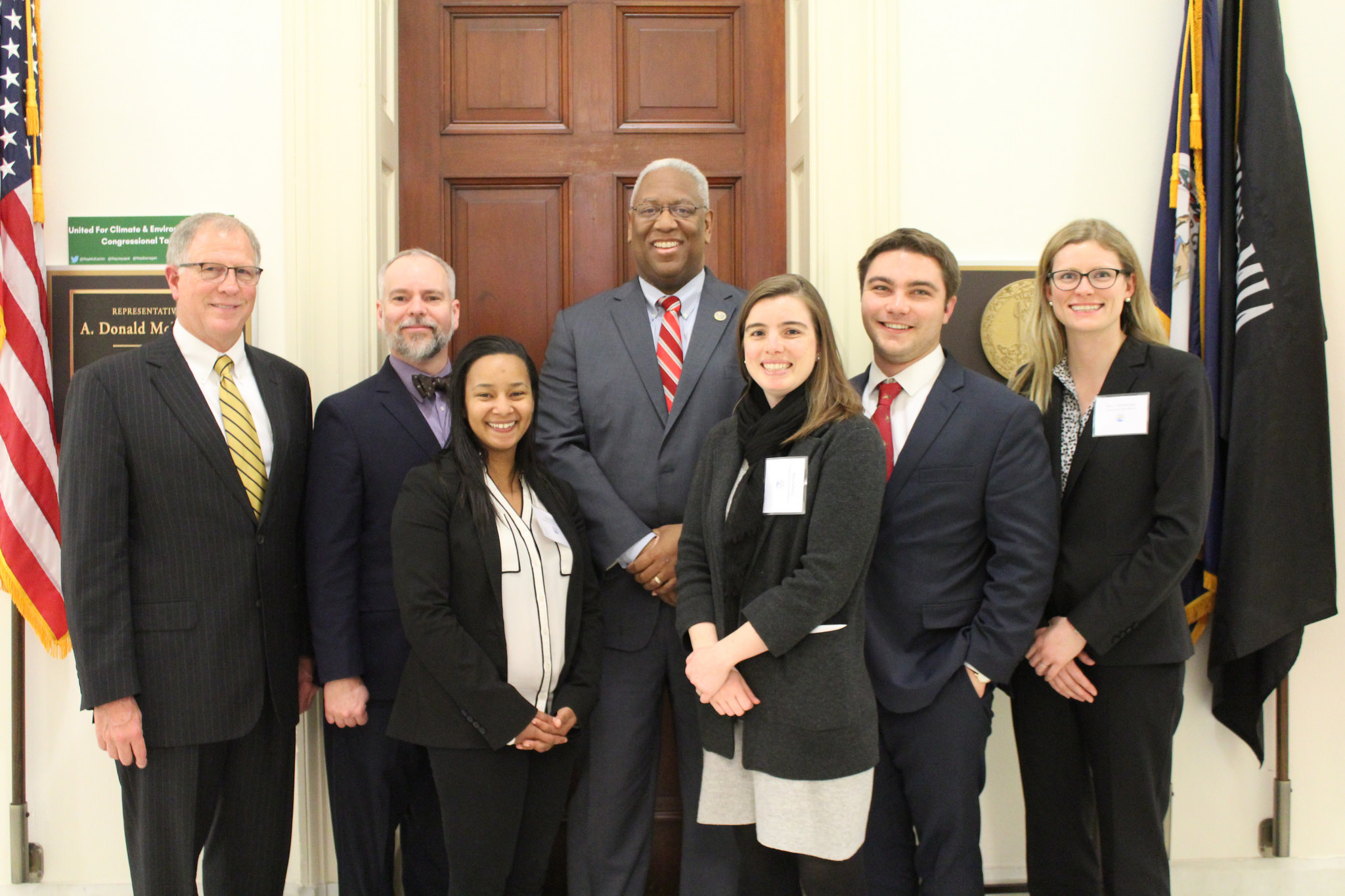

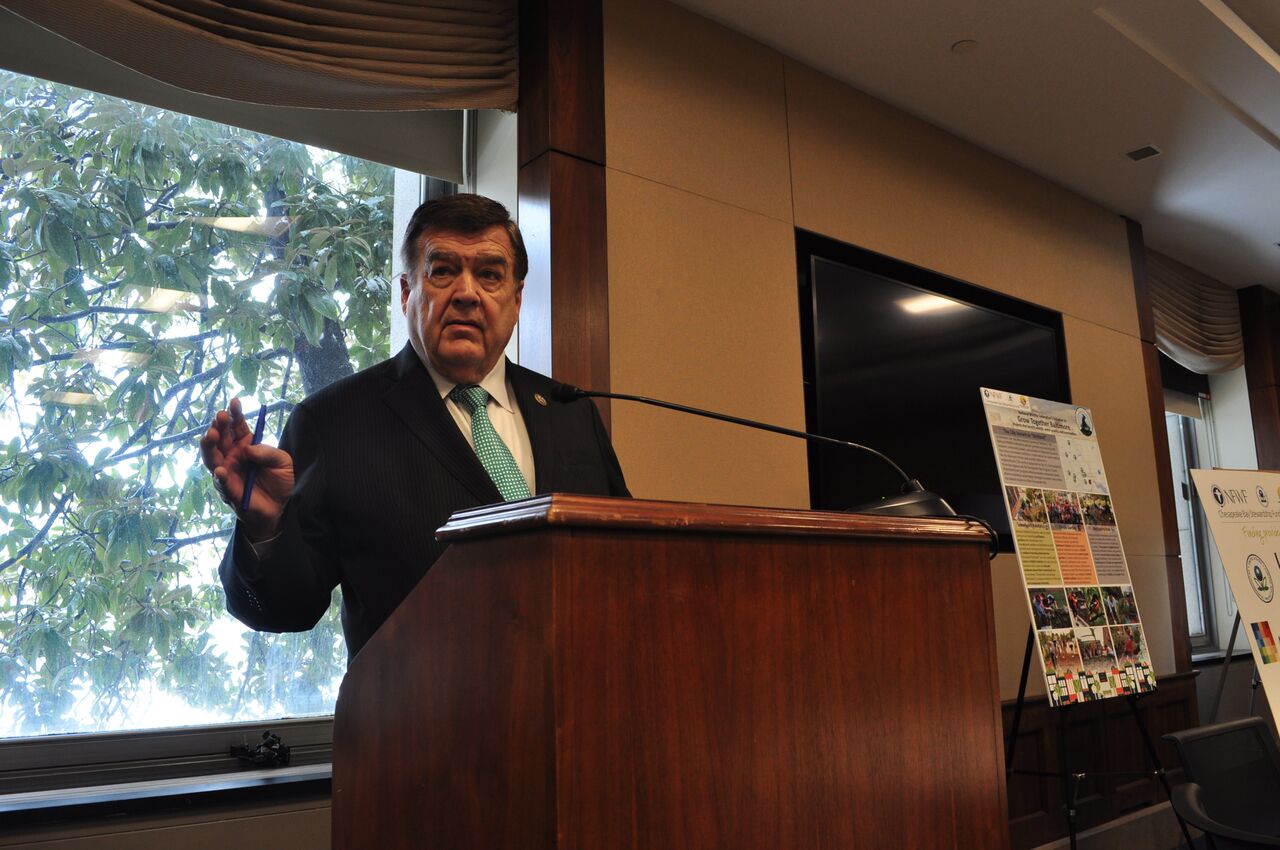
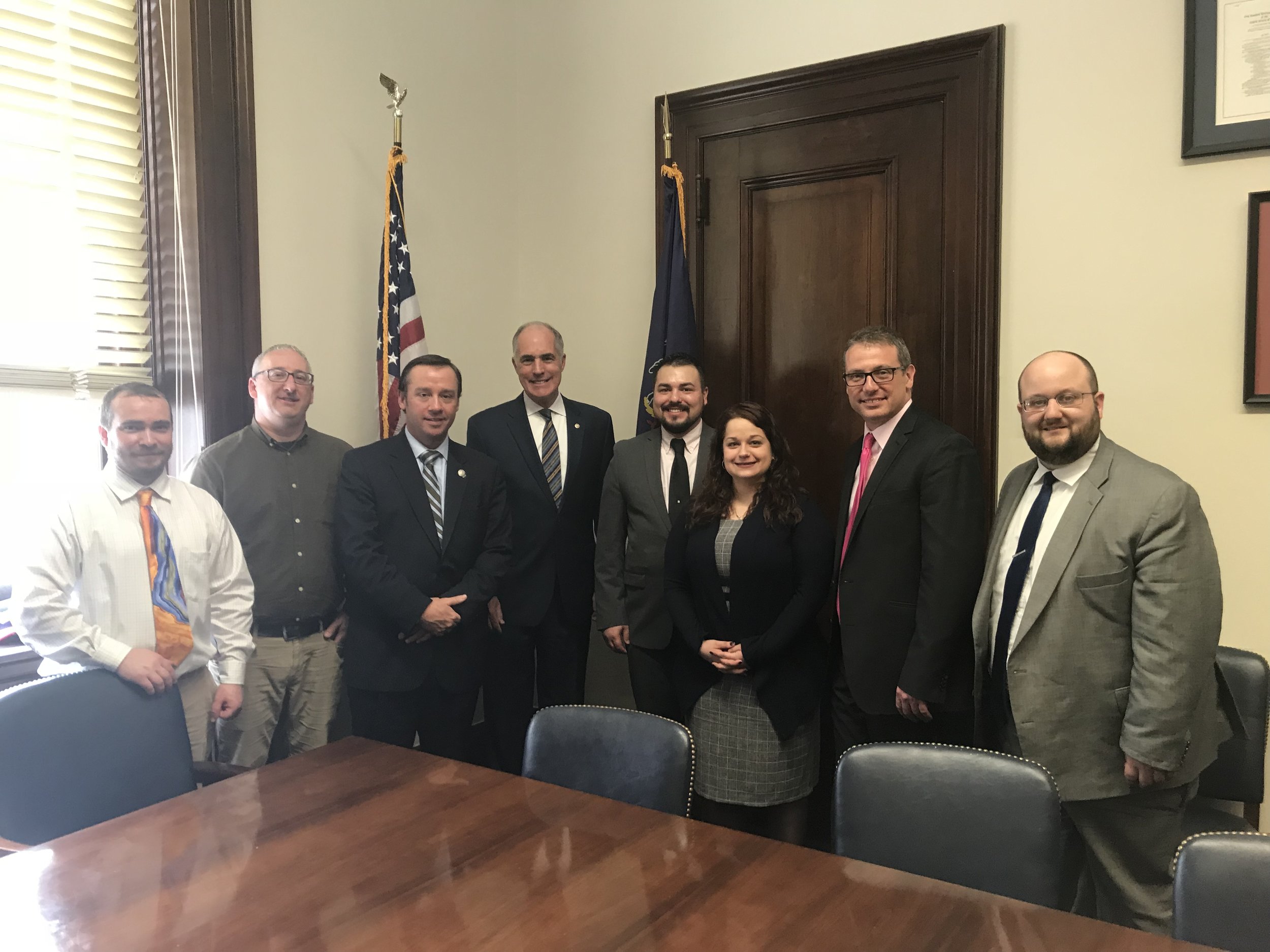
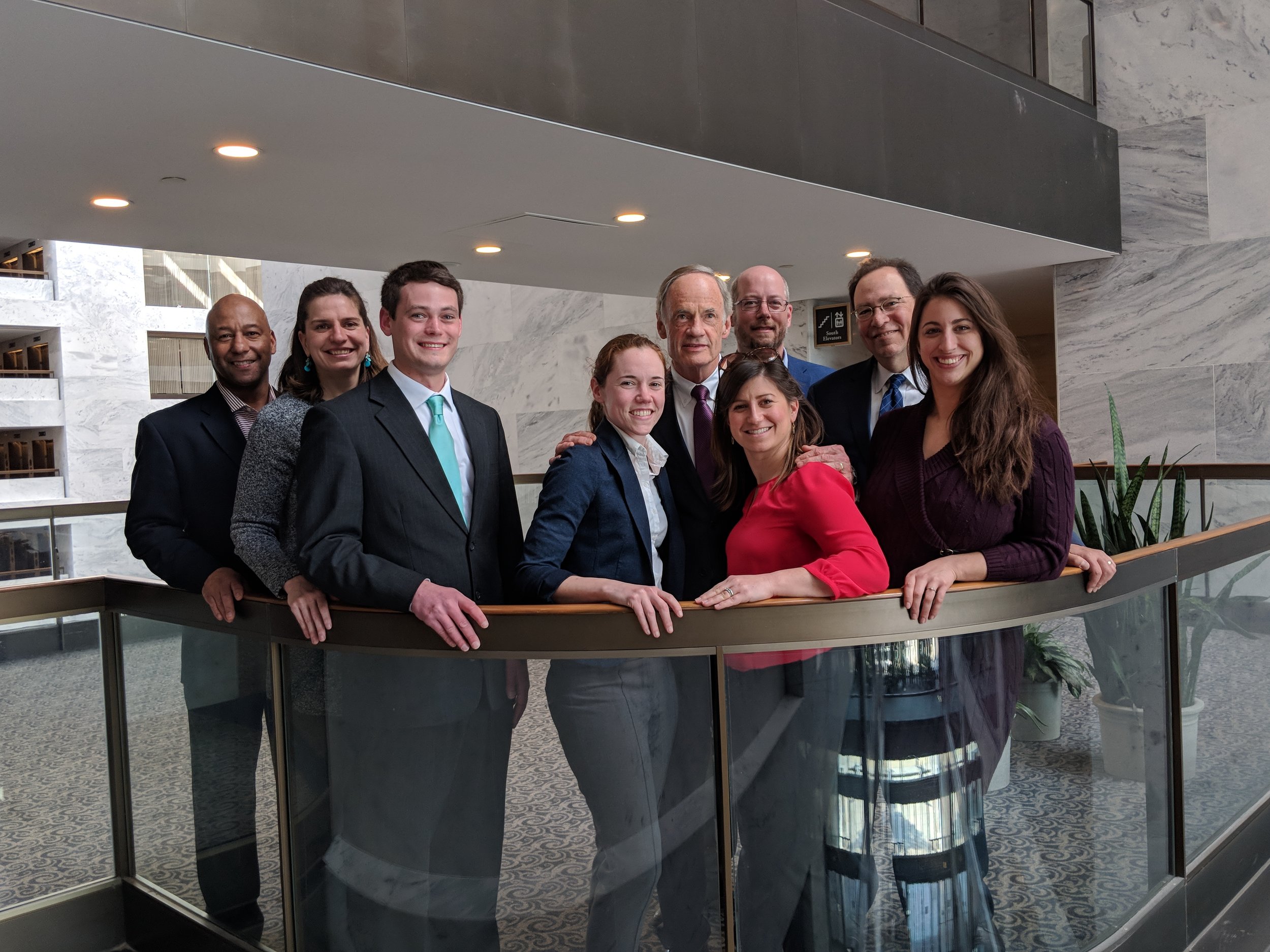
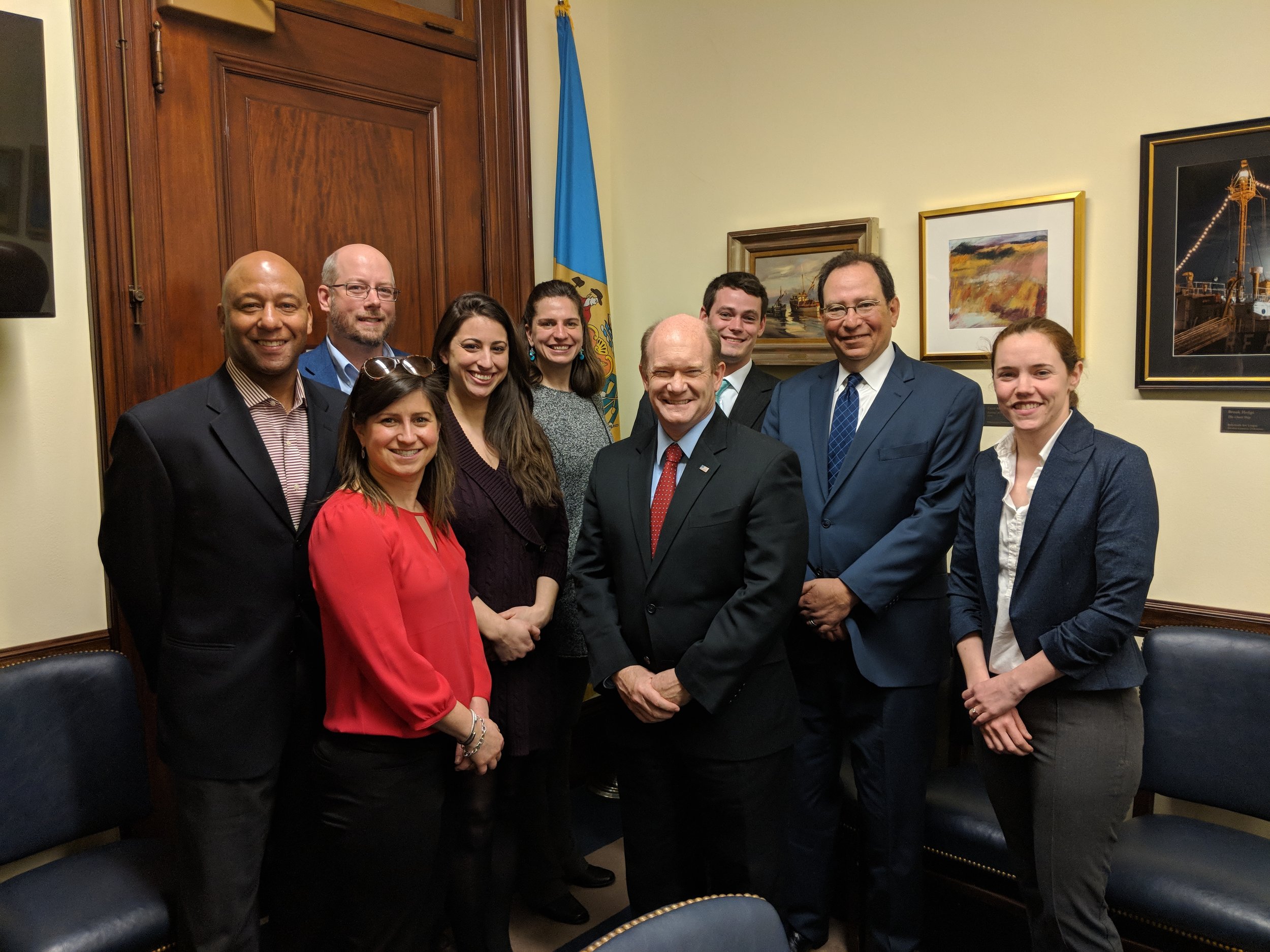
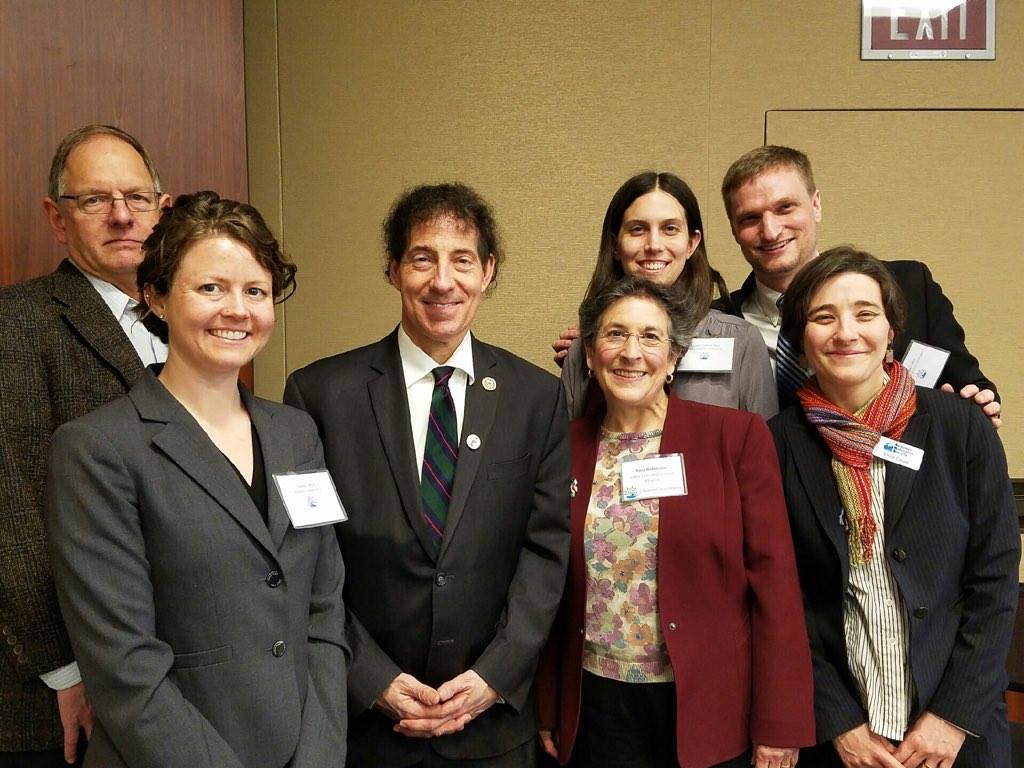
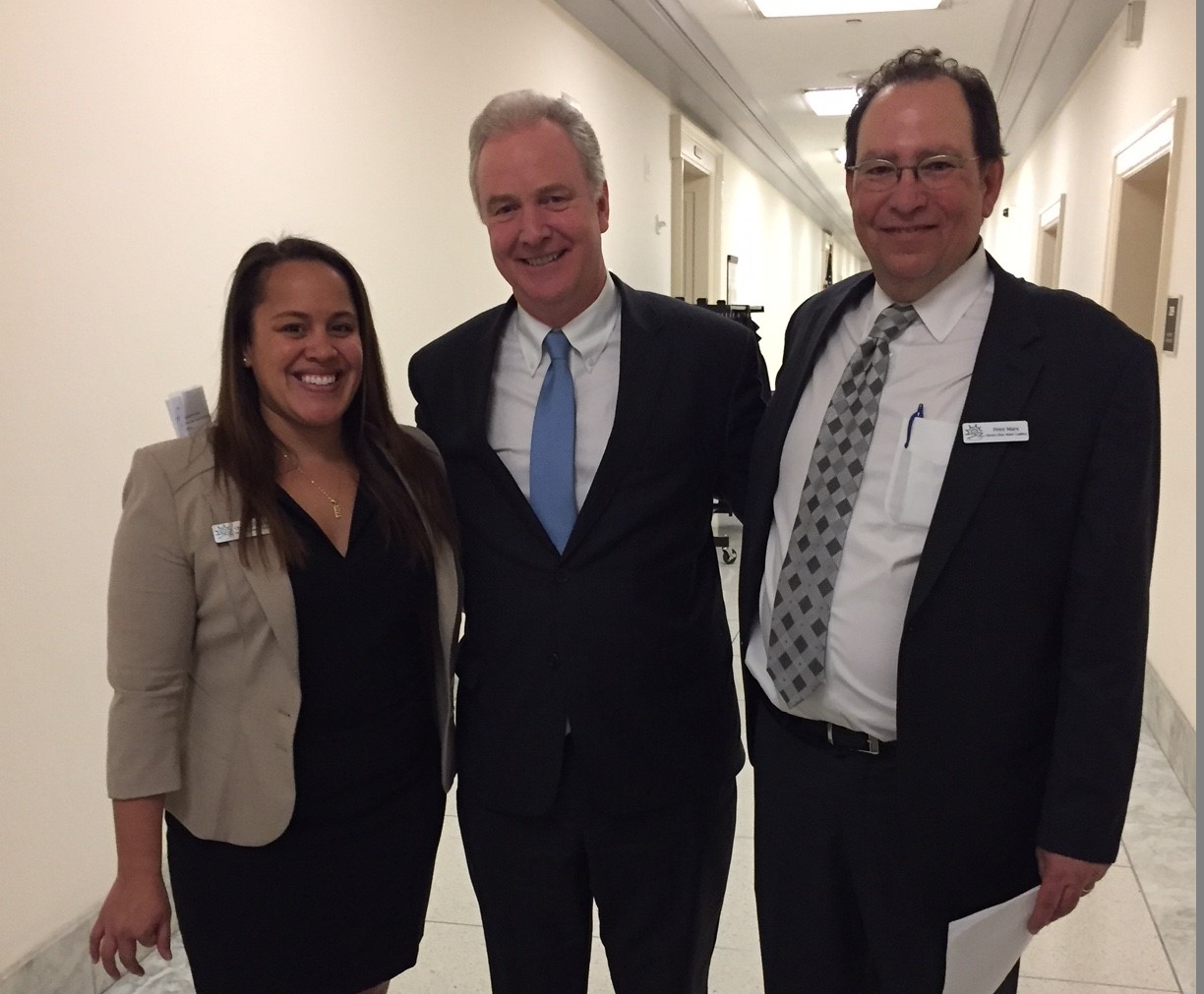
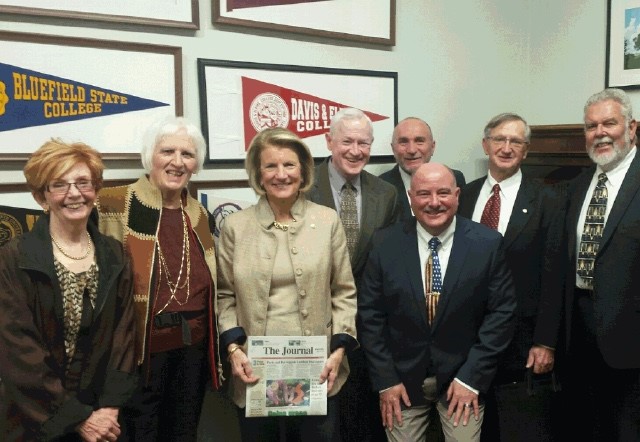
On March 21, more than 100 members of the Choose Clean Water Coalition and the Coalition for the Delaware River Watershed fought through a snowstorm to speak with their members of Congress about the importance of clean water. This was the 6th annual Chesapeake Bay Day on Capitol Hill for Choose Clean Water, a coalition of 239 nonprofit organizations focused on restoring and protecting clean water in the Chesapeake Bay watershed.
Despite the snow, the Coalition met with more than 20 members of Congress to discuss federal threats, like funding cuts to the Chesapeake Bay Program. Coalition members also had the pleasure of hearing from 10 different members of Congress at the Chesapeake Bay luncheon, including Senator Chris Van Hollen (D-MD), Congressman John Faso (R-NY), Congresman Dutch Ruppersberger (D-MD), Congressman Jamie Raskin (D-MD), Congressman Rob Wittman (R-VA), Congressman Bobby Scott (D-VA), Congressman Don McEachin (D-VA), Congressman Don Beyer (D-VA), Congresswoman Barbara Comstock (R-VA), Congressman Gerry Connolly (D-VA). The legislators spoke about life around the Chesapeake, where to find the best crab cakes, and of the future of clean water.
The Coalition for the Delaware River Watershed simultaneously scheduled meetings with the entire congressional delegation that represents the Delaware watershed. Although the snowstorm disrupted several meetings, the tenor of those that did take place was overwhelmingly positive with congressional members pledging to champion the Delaware on Capitol Hill. The result of Coalition’s two days on the Hill was a clear message to Members: fund the Delaware River Basin Conservation Act and its associated grant program the Delaware River Basin Restoration Program (DRBRP), a non-regulatory approach led by the US Fish and Wildlife Service. On March 23, the program received $5 million in funding as part of the fiscal year 2018 Omnibus spending bill approved by Congress. The Coalition for the Delaware River Watershed worked with Congress on the authorization of the Delaware River Basin Conservation Act in December 2016 that created the DRBRP, and through the newly funded program, money will finally begin flowing to local conservation projects throughout the region.
The result of months of collaboration and hard work paid off with the rejection by Congress of Trump’s fiscal year 2018 budget proposal, which aimed to zero out the Chesapeake Bay Program. The spending bill that passed includes a fully funded Chesapeake Bay budget of $73 million and $5 million for the Delaware River. We owe a huge thank you to all of the members of Congress who voted in support of protecting the Chesapeake Bay and the Delaware River. The fight for clean water continues as the president’s proposed FY19 budget has only $7.3 million allocated for the Chesapeake Bay and nothing for the Delaware River.
Bay Advocates Applaud Full Funding for Chesapeake Bay
Photo: Chesapeake Bay Program
In May 2017, the President signed the Consolidated Appropriations Act 2017, which designates $73 million in funding for the Chesapeake Bay Program. This comes on the heels of the release of the President’s proposed budget for fiscal year 2018, which recommended a complete defunding and shutdown of the Chesapeake Bay restoration effort.
For the past eight years, the Choose Clean Water Coalition, a nonprofit organization made up of over 225 local, state, and national groups from all six states in the Chesapeake watershed and the District of Columbia, has worked with members of Congress to help secure this essential funding for the Chesapeake Bay clean up. In early April, the Coalition met with members of Congress to discuss how important the funding is for not only the Chesapeake Bay, but local communities around the watershed.
“The Coalition wants to thank our members of Congress who have been champions of the Chesapeake Bay restoration effort and helped to secure this funding for the Bay,” said Chante Coleman, director of the Choose Clean Water Coalition. “With this support, our members will be able to continue to implement on the ground restoration projects that reduce pollution in our rivers and streams and protect the water that we drink.”
Two thirds of the $73 million that the Program receives goes directly to support state and local level projects in the watershed states. In 2016, Virginia, Maryland and Pennsylvania received more than $10 million each, funding projects that include planting trees, creating habitat, reducing pollution from agriculture, and increasing crab and oyster populations.
“Our progress in restoring the Chesapeake Bay results from the steadfast commitment of many important partners working together toward shared goals. The federal government needs to represent the strong and stable base on which the effort is built, and our commitment must not be allowed to waver,” said Senator Cardin. “Congress soundly rejected the recently proposed elimination of federal funding to the Chesapeake Bay Program and related efforts because nearly every elected official in the watershed, regardless of political party affiliation, knows and appreciates what the Bay provides us. Strong local economies. Flourishing wildlife populations. Recreational opportunities. Our regional identity. But let the recent threats remind us just how diligently we must all continue working together as partners to ensure that the federal government’s dedication to the Chesapeake Bay remains the bedrock of the restoration effort.”
The Coalition is now focusing on fighting the proposed budget cuts for fiscal year 2018 and will continue to work with members of Congress to secure the funding necessary to protect and restore the Chesapeake Bay and its rivers and streams.
Clean Water Advocates Rally for Chesapeake Bay
On April 5, the Choose Clean Water Coalition met with Members of Congress to discuss concerns surrounding funding for the Chesapeake Bay restoration effort. Specifically, the Coalition, a nonprofit organization made up of over 225 local, state, and national groups from all six states in the Chesapeake watershed and the District of Columbia, talked with their members and staff about the impact of eliminating $73 million in funding for the Chesapeake Bay Program on local restoration efforts.
Last month, the President released his proposed budget for Fiscal Year 2018, which recommended that funding for the U.S. Environmental Protection Agency’s Chesapeake Bay Program be eliminated. The majority of this funding, over $45 million, is granted back to Bay watershed state and local communities to support local on the ground restoration efforts. Without this funding support, projects that nonprofits, municipalities, and states are implementing to improve their local communities will end.
Photo: Carolyn Millard
“The proposed budget would leave already cash-strapped state and local governments, as well as community groups and nonprofits, holding the bag,” says Chris Miller, President of The Piedmont Environmental Council in Virginia. “The state and local governments would be left to tackle aging infrastructure like failing sewage treatment systems, and to provide the incentives needed to reduce pollution generated by homes, businesses and farms.”
Funding for the Chesapeake Bay has historically found support from both sides of the aisle, with Republicans and Democrats recognizing the importance of Bay funding for improving local communities, and their rivers and streams. Most recently, members of both the House and Senate have sent letters of support for funding the Chesapeake Bay Program to the White House and Congressional funding committees.
“President Trump has no idea what a major, collaborative effort it has taken to reverse the not-too-distant trend of dead zones and poor harvests in the Chesapeake Bay, which is a National Treasure” said Senator Ben Cardin. “Choose Clean Water Coalition members understand how absurd the president’s Budget Blueprint is and they have seen what a difference a healthy Chesapeake Bay has done to promote a healthy economy. Restoration cannot continue without a strong federal partner. Now, our challenge is to demonstrate to appropriators why it is in their best interest and the nation’s interest to continue funding the EPA’s Chesapeake Bay Program.”
Moving forward, the Coalition will work to continue to push back on the President’s proposed budget, and secure the essential funding that is necessary to return clean water to the Chesapeake Bay.
Maryland Passes Ban on Fracking
In March 2017, a number of successes came out of Maryland’s state legislature, including a ban on hydraulic fracturing. The ban to protect the precious Marcellus Shale formation, local waterways, and drinking water in the Western part of the state had overwhelming, bipartisan support and Maryland’s Republican Governor, Larry Hogan, signed and passed the ban into law noting that, “Protecting our natural clean water supply and natural resources is critically important to Marylanders, and we simply cannot allow the door to open for fracking in our state”. Maryland and New York are the only two states that have banned fracking in the Chesapeake Bay watershed.
The threat of natural gas development within the Bay watershed has been a long contested debate. For the last nine years, the Coalition’s Shale Workgroup has pushed back at the local, state, and regional level to champion precedent setting policies to address the impacts of shale gas drilling. The significance of this historic ban speaks volumes to the work of Coalition members, specifically in Western Maryland. Efforts on the ground in favor of Maryland’s fracking ban legislation was seen from 37 diverse Coalition members, including faith groups, sportsmen, and conservation non-profits. Strong support was vocalized through a series of sign-on letters addressed to Governor Hogan and six state legislators whose districts would be impacted by fracked natural gas.
Maryland’s ban on fracking is not just a huge victory for one portion of the Chesapeake watershed, it will also protect drinking water for tens of thousands of people and species of wildlife. This victory signifies the importance of collaboration and working together. Each member of the Choose Clean Water Coalition -no matter how big or small- plays a key role in protecting the Chesapeake. The ban serves as a Coalition win and demonstrates the power of our ability to provide capacity to our members and drive strategic action for the protection of our natural resources.
Mariah Davis is the field manager for the Choose Clean Water Coalition.
Conservation Collaboration in New York
Wendy Walsh of the Upper Susquehanna Watershed Coalition speaks at the Upper Susquehanna Watershed Forum in Oneonta, New York, on November 3, 2016. The event was organized by the Alliance for the Chesapeake Bay and its partners to share local knowledge regarding restoration in the Susquehanna headwaters.
Wendy Walsh of the Upper Susquehanna Watershed Coalition speaks at the Upper Susquehanna Watershed Forum in Oneonta, New York. Photo: Chesapeake Bay Program
On a peaceful, cloudy day in upstate New York on November 3, 2016, the State University of New York (SUNY) College at Oneonta played host to the first annual Upper Susquehanna Watershed Forum, a chance for upper watershed and Chesapeake Bay representatives to engage with one another and create connections for sharing watershed restoration and protection resources. Communication and collaboration, the unofficial themes of the day, were evident throughout. Opening remarks were a joint effort from Maryland and New York, with Lou Etgen from the Alliance for the Chesapeake Bay and Les Hasbargen from SUNY Oneonta addressing the crowd. They were followed by Mike Lovegreen of the Upper Susquehanna Coalition, who echoed much the same in his State of the Upper Watershed: “We need to address the whole watershed.”
The Upper Susquehanna River forms the headwaters of the Chesapeake Bay watershed, and is unique in that 99 percent of its headwaters are protected and managed by a network of soil and water conservation districts (SWCDs) working together as the Upper Susquehanna Coalition (USC). USC’s structure allows SWCDs, which are established by state law and work to develop locally-driven solutions for natural resource concerns, to enter into multi-district agreements with a memorandum of understanding. These SWCDs work within their own locality, but also use these agreements to share equipment and training with one another. Together, these districts voluntarily work to improve water quality and quality of life for the 7,500 square miles under their care.
The area is overwhelmingly forested—close to 70 percent—which led farms to be built along the banks of streams, directly in the floodplains. “[Sediment pollution] is not running off the farms. It’s the farmland itself” that is eroding away, explained Lovegreen. Following Lovegreen’s State of the Watershed was a local government panel and examples of successful best management practices, or BMPs, with much of the conversation focused on stream restoration.
Attendees of the Upper Susquehanna Watershed Forum, including representatives of local watershed groups, tour Silver Spoon Dairy Farm and their BMP initiatives in Garrattsville, New York, following the conclusion of the forum sessions.
Attendees of the Upper Susquehanna Watershed Forum, including representatives of local watershed groups, tour Silver Spoon Dairy Farm and their BMP initiatives in Garrattsville, New York, following the conclusion of the forum sessions.Photo: Chesapeake Bay Program
Communities take a local approach in the Upper Susquehanna, coming together to address streams in every way possible: at the source, across the landscape, in the stream corridor and with programs. Efforts are guided by the USC’s three focus areas: stream corridor rehabilitation, environmentally and economically sustainable agriculture and wetland restoration. “[The strategy] is a comprehensive public participation approach,” explained Tioga County SWCD’s Wendy Walsh. “Farms and communities have trust in the SWCDs, and that’s how we get things done.” Some restoration work might be triggered by forces of nature, but the effort to address it is personal and actionable.
Discussion of successful BMP efforts allowed opportunities for attendees to problem solve comparable programs in their own areas of the watershed; themed table discussions during the lunch hour provided networking and platforms for creative solutions. Participants left that day to return to their home organizations with individual commitments toward continued restoration and protection activities, and with a desire for more engagement in the future with their colleagues across the Chesapeake Bay watershed.
With continued conferences that provide connections for the work being done all across the watershed and the actions that result from them, the vision of the Upper Susquehanna Coalition may be realized: a well-functioning Susquehanna River headwaters in harmony with itself and the entire Chesapeake Bay watershed.
Caitlyn Johnstone is the Outreach Coordinator at the Chesapeake Bay Program.
Festival del Rio Anacostia
Photo: Anacostia Watershed Society
On October 15th, alongside a mud-banked river usually empty of life, little children skip among brightly tented booths, carrying fishing lines and nature-inspired passport books. Community members watch water run clear through a root-planting demonstration or try to spot American eels in a cloudy-water tank teeming with fish. In the air, marimba music and the tantalizing smells of Latin fare mingle with the musical murmur of combined Spanish and English conversations. A few feet away, a paper mural of insects is constantly expanded as everyone tries their hand at drawing local bugs. This is the Festival del Rio Anacostia, and it’s impossible to decide whether you are at an environmental event or a cultural celebration.
That perfect fusion is certainly true for Ricardo, an English-speaking local resident who heard about the event through a Spanish-scripted Facebook post. Recognizing the word “festival,” he thought it’d be a nice way to spend an afternoon and enjoy some good food. Not until arriving did he realize the festival was heavy with nature awareness. “That’s good!” he exclaims. “We have to live in it. Anything we can do to make it better for me, for you, for the younger generation coming up, you know… be a participant. You learn and take it back to your own neighborhood.” He planned to take pictures and share them with people in his neighborhood that couldn’t make it that day—allowing them to witness the good food, dancing and environmental lessons alike.
Coming together and collaboration were evident in the creation of the festival as much as the event itself. It began as an idea of the Latino Outreach Subcommittee of the Anacostia Watershed Citizens Advisory Committee. Before long, a diverse array of government bodies, citizen committees and environmental organizations offered their capacities and expertise. The space at Bladensburg Park was donated, along with the tents and chairs. Music was provided by Guate Marimba and entertainment by Despertar Maya Ma’am in conjunction with Asociacion de Guatemaltecos Sin Fronteras. Parks and Recreation Maryland-National Capital Park and Planning Commission, Anacostia Watershed Society, Chispa, Metropolitan Washington Council of Governments, Interstate Commission on the Potomac River Basin, Friends of Sligo Creek, Chesapeake Bay Trust and Anacostia Riverkeepers were all heavily involved in making the festival a reality.
Being aware of your environment and learning to care for it go hand in hand, and organizers do their best to highlight that intersection. Most booths have both English- and Spanish-speaking personnel; at others, roving translators are available and happy to help. For those without readily available transportation, buses run throughout the day to pick up attendees for the festival and later take them back home. “In many cases due to language and economic barriers, Latinos do not have an opportunity to recreate in the Anacostia River,” wrote Chispa Maryland Program Director Ramon Palencia-Calvo. “[This festival] open[s] the river to this environmentally underserved community.”
Indeed it does, and plans are already underway for a Festival del Rio Anacostia 2017. For more information or to get involved with next year’s festival, contact rpcalvo@mdlcv.org.
Caitlyn Johnstone is the Outreach Coordinator at the Chesapeake Bay Program.
Federal Funding Secured for Pennsylvania Agriculture
Photo: Chesapeake Bay Program
On October 4, at the annual meeting of the Chesapeake Executive Council (EPA Administrator, Bay state governors, the mayor of D.C. and the chair of the Chesapeake Bay Commission) it was announced that over $28 million would be available for targeted agricultural conservation practices in south-central PA. The breakdown of funds was approximately:
- $12.7 million from the US Dept. of Agriculture
- $11.8 million from PA state agencies
- $4 million from EPA
This is a big deal! A small portion of these funds had already been announced and disseminated (e.g., $3 million of EPA money announced by NFWF in August at their Chesapeake Stewardship Grants press conference), but these very targeted funds are critical to pick up the pace on agricultural lands in south central PA.
The Coalition has been very active all year trying to obtain additional funds for agriculture in PA, working with various Members of the House and Senate, meeting with officials at the Council on Environmental Quality in the Executive Office of the President, OMB, USDA and EPA.
Taking Nature Black
More than 100 attended the inaugural Taking Nature Black: An Audubon Naturalist Society (ANS) Black History Month Celebration, Saturday, February 20, 2016.
“We are thrilled you all were able to join us today for this inaugural Black History Month celebration,” said ANS Executive Director Lisa Alexander. “Our vision is to create a larger and more diverse community of people who treasure the natural world and work to preserve it; so events such as these give us an opportunity to open the doors wider and reach a greater number of nature enthusiasts.”
The day-long event was held at ANS headquarters, Woodend Nature Sanctuary, and began with a Green Jobs Fair. Twenty environmental industry employers participated including Chesapeake Bay Foundation, Department of Recreation and Parks Baltimore City, National Aquarium, National Wildlife Federation, Blue Water Baltimore and Natural Resources Defense Council. College students, retirees and professionals of color came to the Taking Nature Black event for the Green Jobs Fair, to find short-term and long-term paid and volunteer opportunities.
“The Chesapeake Bay Program’s Diversity Action Team is proud to work with the Audubon Naturalist Society in encouraging our partners to participate in Audubon’s inaugural Black History Month celebration,” said James Edward, Deputy Director, Chesapeake Bay Program. “It is important to acknowledge and celebrate the rich history of all people in the watershed. Events like Taking Nature Black help facilitate an inclusive restoration workforce with meaning.”
The Chesapeake Bay Program’s Diversity Action Team, an event partner, specifically helped to produce the Green Jobs Fair. Choose Clean Water Coalition and M-NCPPC, Montgomery Parks also partnered with ANS on Taking Nature Black. Chesapeake Bay Foundation and Seaberry Design & Communications were event sponsors.
Breakout sessions on environmental advocacy, cultural competency and stewardship practices at home or in local communities were also part of the day’s draw. Speakers for the Environmental Advocacy Panel & Listening Session included Vernice Miller-Travis, Vice Chair of the Maryland State Commission on Environmental Justice and Sustainable Communities, member of the US Environmental Protection Agency National Environmental Justice Advisory Council and member of the DMV Environmental Justice Coalition; Irv Sheffey, Environmental Professionals of Color; and ANS’s Conservation Program Director Diane Cameron. The panel held a spirited discussion on the environmental issues facing African American/Black communities.
Judy Cohall, Senior Training Manager, M-NCPPC, Montgomery Parks; Whitney Tome, Director of Diversity and Inclusion, National Parks Conservation Association (NPCA); and Nataki Kambon, Spokesperson, LetsBuyBlack365.com Black Economic Empowerment Movement delivered the session on cultural competency, Working While Black in a Green Industry. Mayor Jacqueline Goodall, Town of Forest Heights; Dennis Chestnut, Executive Director, Groundwork Anacostia; and Alan Spears, Director of Cultural Resources, Government Affairs, NPCA talked to attendees about Keeping it Green at Home. The group shared best practice stewardship tips and information on the importance of protecting nature in local, regional and national parks.
“Taking Nature Black is a unique opportunity for students, community members, and professionals to come-together and learn about environmental issues impacting our neighborhoods. This is a time for us to build relationships with one another, increase our cultural competence, and celebrate a month dedicated to fairness, equity, and inclusion. Choose Clean Water Coalition is excited to partner on Audubon Naturalist Society’s first-ever Black History Month event,” said Jill Witkowski Heaps, Director, Choose Clean Water Coalition.
The day’s keynote address, Green Stories in Black, was delivered by Bob “The Griot” Smith, Storyteller/Actor and President of the Griots’ Circle of Maryland, National Association of Black Storytellers. Bob inspired and entertained.
An onsite display, Black In Nature: Then & Now, featured African American/Black pioneers who have made and are making contributions to nature and the environment. This display featured images and biographic information for: John James Audubon, Sophia Danenberg, John Francis, Reverend Josiah Henson, Lisa Jackson, Frank and Audrey Peterman, Fred Tutman and Michael Twitty.
“The rich African American stories we are able to interpret through the historic sites in Montgomery County parks really makes Black History Month come alive,” said M-NCPPC Montgomery Parks Museum Manager Shirl Spicer. “When ANS approached us about partnering on their first-ever celebration, we were happy to expand our celebration as Josiah Henson Park is right in the neighborhood of Woodend.”
ANS provided a light breakfast, lunch and cocktail party reception to event attendees. The catering was done by Uprising Muffin Company and Woodland’s Vegan Bistro.
What a great day of celebration and new beginnings for Audubon Naturalist Society,” added Alexander. “Let’s not lose this momentum; we hope to see you all back soon for upcoming author events, member events or nature classes and programs.”
Taking Nature Black will return in February 2018! To partner, sponsor, or for more information, please contact conference chair Caroline Brewer at caroline.brewer@anshome.org.
Virginia is for #CleanWaterLovers
As you enter the beautiful state of Virginia, you will often pass a sign reading “Virginia is for lovers.” This slogan is the Virginia motto; and it’s awesome. But, what else is Virginia for? What do these “lovers” love? Well, Virginians love clean water and we have the numbers to prove it.
In 2015, the Coalition, its members, and environmental organizations across the country worked to ensure adoption of the the Clean Water Rule. This rule is necessary to protect streams and wetlands and keep pollution out of water that Americans rely on for drinking, swimming, and fishing. Shortly after the rule was adopted by the Environmental Protection Agency and Army Corps of Engineers, it came under attack in Congress. We needed to target decision-makers to ensure this vital rule was not rolled back and our most vulnerable streams remained protected.
To be successful, we needed to influence Members of Congress in the Chesapeake Bay watershed, build broad support for clean water, and ask them to resist attacks on the Clean Water Rule and other federal clean water protections. We started this work in Virginia.
The Coalition and the Hatcher Group launched a 4-week campaign to inform and reassure Senator Mark Warner (D-VA), a long-time clean water champion, of the widespread support Virginians have for the Clean Water Rule, and to encourage him to stand against any weakening of its protections. The goal was to flood social media with a steady drip of posts resulting in a deluge of messaging that could not be ignored. The campaign included a series of four broad themes on Facebook and on Twitter: (1) Beer and Wine; (2) Families and Pets; (3) Virginia Pride and Heritage (landmarks/waterways); (4) Wildlife (sportsmen and recreation).
Weekly social media toolkits and shareable graphics were distributed to the Choose Clean Water Coalition members. The campaign used various calls to action including: “Take a photo of how you and/or your family enjoy clean water, and post it using #CleanWaterLovers.” This call to action was included as one option among several suggested posts each week.
Overall participation in the campaign on Twitter was extremely high, with a total reach of more than 1.1 million accounts and a total exposure of more than 2.4 million! Facebook received even more engagement and reach. Most importantly, this campaign gave constituents the ability to engage their Senator through social media and, in the end, Senator Warner stood up for the Clean Water Rule!
We encourage everyone to thank their member of Congress for protecting clean water.
Coalition Releases Diversity Toolkit
Photo: Carolyn Millard
In an effort to continue to increase diversity, equity, and inclusion across the Chesapeake Bay watershed, the Coalition created the first diversity toolkit.
The toolkit is designed to help organizations increase their own diversity through thoughtful and deliberate focus and intention.
For more information, please contact Chante Coleman.
Coalition Launches Environmental Justice Workgroup
Photo: Sierra Club
In 2015, the Coalition launched its Environmental Justice Workgroup. This group was created in order to provide Coalition members with a space to collaborate and organize around issues relating to equity in the Chesapeake Bay watershed. You can learn more about the workgroup here.
$73 Million Secured for Chesapeake Bay Restoration Effort
Photo: Chesapeake Bay Program
In 2015, the Coalition helped to secure $73 million in federal funding for the Chesapeake Bay Program - the most that the program has ever received. $12 million of the $73 million in fundsing was also designated for Nutrient Reduction and Small Watershed grant programs that provide support for on the ground restoration work around the watershed.
Citizen Voices Protect George Washington National Forest
Living next door to the 1.1-million acre George Washington National Forest, along the mountainous Virginia/West Virginia border, has both pros and cons. Pros are clean air and water, many more tree neighbors than people, and the right of every citizen to tell the government how to manage this beautiful public forest. Cons are tourists, forest fires and the right of every corporation to tell the government how to manage this bountiful public forest.
For the last three years, the management plan for the forest has been delayed as corporate and citizen voices made a discordant buzz. Yet, the Forest Service has managed to make something harmonious out of the final plan that was released on November 18, 2014. Over those last three of my 30 years here, I’ve watched our maternity roost of little brown bats dwindle from dozens to zero and most of the hemlock trees die. Even that embodiment of childhood delight in discovery, the box turtle, has almost disappeared.
This forest is home to thousands of species of plants and animals that need wild forests to survive. It is the largest intact forest in the East and a globally ranked biodiversity hot spot, yet even here, about 200 species are rare or declining because of human impacts.
If life is any measure of stewardship, then the last thing the George Washington National Forest needs is habitat destruction through gas or oil drilling.
What has proliferated in the last three years are geological maps of the Marcellus Shale gas formation and drilling leases on thousands of privately owned acres around me. Most of the national forest lies atop the Marcellus shale.
Also during the last three years I took a frack-finding trip to a West Virginia Host Farm (www.wvhostfarms.org) in Doddridge County. The intensely industrial processes of hydraulic fracturing for shale gas (fracking) have deforested and polluted thousands of acres there. Shredded roads, fatal accidents, toxic spills, toxic fumes and residents with recently developed respiratory diseases were just part of all we learned. The drilling rig I fell asleep watching from the host farm window exploded two months later, killing two workers.
Back home, my human neighbors who at first thought fracking was like the hole-in-the-ground gas wells of the past, also spent the last three years educating themselves. The Texas gas company that leased land here is now letting its leases expire, citing a disappointing test well nearby, plus “local resistance.”
Anti-fracking sentiment was further expressed in more than 90 percent of 53,000 comments to the draft George Washington National Forest management plan issued by the Forest Service three years ago.
And it was those voices that prevailed. “The Forest Service listened to local concerns and made most of the forest unavailable for future gas and oil leasing in the new plan,” said Sarah Francisco of the Southern Environmental Law Center. “Only where minerals rights are not owned by the government, on scattered lands that comprise well under 20 percent of the GWNF, could any fracking take place. The public is much better served by protecting these natural systems that we all depend on for so many essential resources.”
National forests are a modern version of the commons, the most ancient, universal form of land tenure, and one that was traditional in these Appalachian Mountains. As a commons, the national forest benefits everyone, even people who have never heard of it. Millions of people annually gain clean water and air; erosion and flood control; carbon sequestration; timber and non-timber products; and opportunities for recreation, study and solitude available nowhere else in the East.
While the new plan sets higher targets for logging, prescribed burning, and biomass harvests than in the original draft, it also recommends more new and expanded Wilderness Areas and a large National Scenic Area. If Congress acts on the recommendations, these areas will be permanently protected from most forms of extractive use. This seems a reasonable balance that reflects the diverse demands of many diverse stakeholders.
It was courageous of the U.S. Forest Service to stop oil and gas leasing despite industry pressure, and I’m grateful. For three years, I have watched as my tree neighbors grew the three thin dendritic rings that will be hardly noticeable in the dense wood of an oak that can reach 600 years. Those trees, and all the lives they harbor, have a good chance of surviving under the new plan. And maybe the U.S. Forest Service’s rejection of industrialized energy in the George Washington National Forest will help against the next big threat: the massively destructive Atlantic Coast (fracked gas) Pipeline planned by Dominion Resources across the most ecologically sensitive parts of the forest. Life in the forest remains at risk.
Chris Bolgiano is the author or editor of six books and innumerable articles about forestry, ecotravel and rural life. Visit www.chrisbolgiano.com.
Distributed by Bay Journal News Service, a non-profit news organization that distributes original content to news outlets in the mid-Atlantic. It is free to use.
Engaging the Faith Community
In partnership with Interfaith Partners for the Chesapeake, the Coalition worked to highlight the importance of faith-based communities in our restoration effort.









